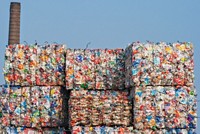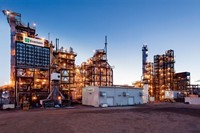Advertisement
Grab your lab coat. Let's get started
Welcome!
Welcome!
Create an account below to get 6 C&EN articles per month, receive newsletters and more - all free.
It seems this is your first time logging in online. Please enter the following information to continue.
As an ACS member you automatically get access to this site. All we need is few more details to create your reading experience.
Not you? Sign in with a different account.
Not you? Sign in with a different account.
ERROR 1
ERROR 1
ERROR 2
ERROR 2
ERROR 2
ERROR 2
ERROR 2
Password and Confirm password must match.
If you have an ACS member number, please enter it here so we can link this account to your membership. (optional)
ERROR 2
ACS values your privacy. By submitting your information, you are gaining access to C&EN and subscribing to our weekly newsletter. We use the information you provide to make your reading experience better, and we will never sell your data to third party members.
Business
Reverting Waste Plastics To Oil
Companies are attempting to add plastics-to-oil technology to the waste management arsenal
by Alexander H. Tullo
March 3, 2014
| A version of this story appeared in
Volume 92, Issue 9

As useful as plastics are, what happens to them after they are thrown away isn’t pretty.
The recycling codes—No. 1 through No. 7—molded unobtrusively into plastic products are little more than wishful thinking. Only the first two plastics—polyethylene terephthalate (PET) and high-density polyethylene—are recycled in appreciable amounts. The rest aren’t valuable enough to sort and mostly end up in the landfill or, even worse, as litter.
A few entrepreneurs envision a different fate. They are trying to solve the plastic waste problem and at the same time harness the energy that for decades has been buried at the dump. These people are using pyrolysis to break polymers apart and turn them into synthetic crude oil and other hydrocarbons. They are, perhaps poetically, returning plastics to the state from which they started.
In an effort to raise awareness of the technology, the Plastics Division of the American Chemistry Council, an industry trade group, set up the Plastics-To-Oil Technologies Alliance early this year with three companies developing the technology: Agilyx, Cynar, and RES Polyflow.
It isn’t hard to see why ACC is involved—plastic waste and litter are perennial black eyes for the industry. “The plastics division for many years has worked to ensure that plastics, at the end of their use phase, don’t end up littered,” says Steve Russell, the trade group’s vice president of plastics.
Plastics-to-oil companies are at various stages of developing the process. One of the furthest along is Akron, Ohio-based RES Polyflow. Last October, the company conducted a demonstration campaign at a reactor that can process 5,000 lb of plastics into oil per hour.
After it receives bales of postconsumer plastic waste, Polyflow conducts a rough sort to get rid of nonplastics. Chief Executive Officer Jay Schabel jokingly calls this stage of the process “getting rid of the deer carcasses and anvils.” Polyflow then shreds and extrudes the plastics into dry, condensed pellets that are ready for the reactor.
The low-oxygen conditions and temperatures of more than 800 °F in the reactor break the polymers down into much smaller molecules. While still in the reactor, these molecules are chemically combined to form a mixture of C5 to C30 hydrocarbons that Schabel says is akin to light, sweet crude oil.
The process, Schabel says, can handle any plastic, although he would prefer to receive plastics containing as much carbon and hydrogen as possible. PET, he points out, reduces the fuel yield; about one-third, by weight, of the polymer is oxygen.
This is a big reason why advocates of the technology claim it complements the existing PET recycling industry, which converts the plastic into fiber or new bottles. Pyrolysis operators are more than happy if a reclaimer plucks old soda bottles out of the plastics waste stream. “When communities think about waste management in an integrated way, it is possible for everybody to win,” ACC’s Russell says.
Overall, the output of Polyflow’s process is about 70% salable oil and 30% inert materials that form char, as well as condensable gases, including hydrogen, methane, and propane, that Polyflow uses as fuel to sustain the process.
Such a yield isn’t too bad, according to Nickolas J. Themelis, director of the Earth Engineering Center at Columbia University. A ton of plastics contains the energy of about 5 barrels of oil, he says; pyrolysis should yield 3–4 bbl of product.
Should plastics-to-oil technology be applied broadly, it could yield an enormous amount of energy. According to the Earth Engineering Center, of the 34.3 million tons of plastic waste generated in the U.S. in 2011, 81.1% ended up in the landfill. Only about 7.8% was recycled, and 11.1% was incinerated with other trash in waste-to-energy facilities. Plastics-to-oil plants could hypothetically convert the landfilled plastic into 84 million bbl of oil, enough to power about 6 million cars for a year.
In gauging the potential of plastics-to-oil, Themelis compares it with waste-to-energy, a process that is practiced in Europe and Asia but isn’t common in the U.S. Converting plastics to oil is more expensive than converting waste to energy because of the need to sort waste, but the process yields about $300 worth of oil per ton of plastic at current prices, about three times the value of waste-to-energy conversion, Themelis says.
Selling the product is the tricky part. Oil refineries are orders of magnitude bigger than plastics-to-oil plants. “We are such a small opportunity for them, it is difficult to get any attention,” Polyflow’s Schabel acknowledges. His firm’s solution is to fractionate its product into diesel and gasoline itself.
Getting the economics right will be a challenge for the fledgling industry. JBI runs a plant in Niagara Falls, N.Y., where it converts used Crayola markers and other materials into fuels. The firm recently announced a $10 million loss on $550,000 in sales over nine months.
Themelis says the world would be a better place if the emerging plastics-to-oil industry could succeed in offering a solution to the waste problem while helping with dwindling energy supplies. “We should create such an industry,” he says. “No question.”





Join the conversation
Contact the reporter
Submit a Letter to the Editor for publication
Engage with us on Twitter